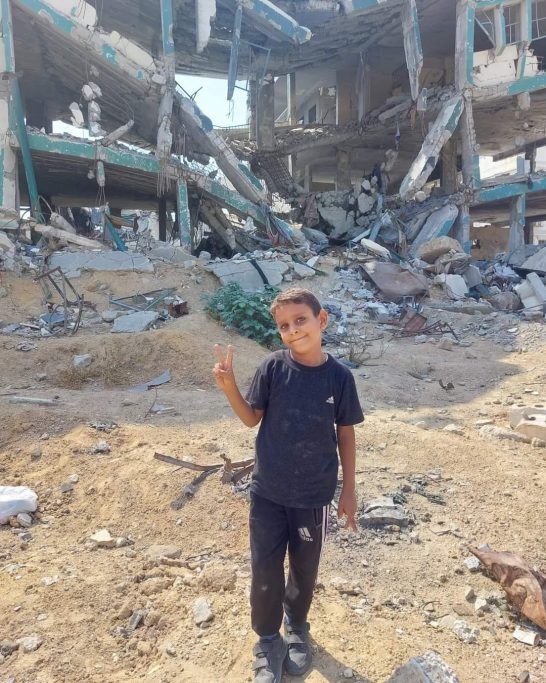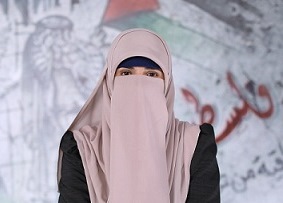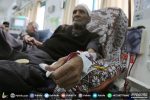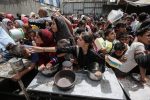It’s back-to-school season in occupied Palestine, but for the beleaguered Palestinians in the Gaza Strip, the prospect of another school year amidst the carnage and starvation of the Israeli war will not mean new books, uniforms, and courses. Ordinarily, the start of every new academic year is a celebratory occasion, the streets and schools bustling with students dressed in new uniforms, open markets filled with people buying school supplies. All these rituals have entirely disappeared this year in the afflicted Gaza Strip. Last year, the Israeli onslaught broke out less than a month into the new school year, disrupting the joyous season.
Last August, Sarah Shukri, 11, was excited to wear her new pink backpack to her new school for the new year. “My father bought me a pink bag which I liked the most,” she told the PIC. “I never expected that I would wear it to move from one displacement zone to another escaping the Israeli bombardment.” Last October, the Israeli occupation army designated Gaza City and northern parts of the tiny enclave as “dangerous combat zones,” ordering Palestinian families to relocate to the southern Gaza Valley. Sarah, along with her extended family, were forcibly displaced multiple times, from Jabaliya to Nuseirat Refugee Camp to Rafah then to Almawasi area.

Sarah complained that instead of standing lines for the school morning queue, she queued for long hours every day to fill a container of water from more than a kilometer away, or to fetch bread or free food from the charity kitchen. The queues have become an endemic aspect of the ongoing Israeli onslaught, found everywhere across Gaza due to the densely populated areas.
Every day, Sarah leaves her canvas home in the Almawasi area, which has been their refuge for months, crossing just a few steps over the sand to arrive at her canvas school, without school uniform or new shoes or stationery or books. Since of the tightening of the closure nearly eleven months ago, no stationery items or clothing, amongst other ordinary goods, have reached the beleaguered Palestinians in the enclave.
The current genocidal war has forced most of the children in Gaza to work to help sustain their families under the severe manmade crisis which has pushed all of the people in Gaza into reliance on international aid for survival. Moaed Shnaiwrah, 13, told the PIC, “I used to be one of the top students in my class. I kept the books and notebooks in my bag for several months, until we were forced to use them all to make fire to cook and make bread.” Like other children in Gaza, he has been working to earn money to help his family. “I used the papers for my small business. I sell popcorn to other kids and use the papers as bags because there are no Nylon bags available,” he continued. School has now become a home for Moaed, where he and his family are seeking refuge, but because of the damage from bombardment, the school is no longer adequate to be used for teaching. The school infrastructure in Gaza will require many years after the end of the Israeli bombardment to be restored to functionality.

The educational sector has been deeply impacted as a result of the hermetic Israeli siege and Israeli aggressions. In the ongoing offensive, over 90% of Gaza’s school buildings have been destroyed or damaged by Israeli bombardment, while the rest have turned into emergency shelters housing thousands of displaced families, as schools are supposed to be internationally protected facilities. Yet, the schools in Gaza have not been spared from the Israeli strikes, where thousands of displaced people have been murdered by the bombardment as they sought refuge in the schools. According to the Gaza media office, there are a total of 803 schools in Gaza; 448 government schools, 288 UNRWA schools, and 67 private schools, as well as the thousands of school-aged students who are deprived of their schooling.
Melissa Fleming, UN Under Secretary-General for Global Communications stated on X, “45,000 6-year-olds in Gaza should have been starting their first day of school today. Under international humanitarian law, students, teachers and schools are protected. Warring parties must not direct attacks against them.”
Education for Palestinians is so significant. The population of Gaza is one of the most literate in the world. Literacy rates are highest in the Gaza Strip, with a literate population of 96.8%.
The attempts to preserve education in Gaza are ongoing, whether by individual initiatives, local organizations, or UNRWA. Last month, UNRWA initiated a back-to-learning program in 45 of its shelters, trying to teach some of the students in these shelters the basic subjects like Arabic, Math, and English. The Ministry of Education announced that they will use electronic learning systems. Teachers across Gaza, who are also buckling under the load and dealing with their own struggles, say that the genocidal war has left marks on them yet many have begun their own initiatives to educate children in tents in displacement areas.
-Wafa Aludaini is a Gaza-based journalist. She contributed this article to the Palestinian Information Center (PIC).











